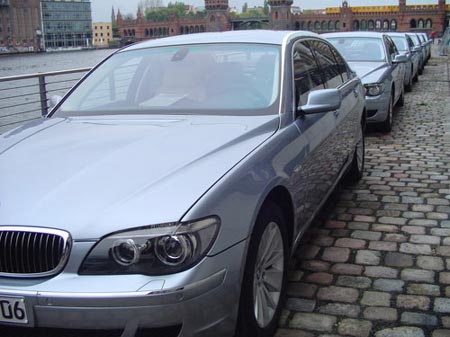 BMW decided that it would do its hydrogen vehicle in a different way than most. Rather than building a hydrogen fuel cell electric vehicle, BMW chose to stick with what it already knew well, internal combustion engines. Set to debut at the Los Angeles Auto Show at the end of this month, the resulting Hydrogen 7 uses a dual-mode drive that is driver selectable at the flip of a switch.
BMW decided that it would do its hydrogen vehicle in a different way than most. Rather than building a hydrogen fuel cell electric vehicle, BMW chose to stick with what it already knew well, internal combustion engines. Set to debut at the Los Angeles Auto Show at the end of this month, the resulting Hydrogen 7 uses a dual-mode drive that is driver selectable at the flip of a switch.
The 6-liter V-12 can run on either hydrogen or premium gasoline. It only produces 260 horsepower, but that’s still enough to get it from 0-62 mph in less than 10 seconds. Using both the 19.5-gallon gas tank, and another tank that stores 17.6 lbs. of liquid hydrogen, the range is about 400 miles, or 125 on Hydrogen alone. If you run low on hydrogen, the computer will switch you over to gasoline automatically.
But you already knew most of this if you read our post on the Hydrogen 7 last month. Wired News just got their hands on one (lucky dogs), and did an excellent review of the experience, which is what brings the car to our attention again today. Follow the jump for more details and click the read link for the complete writeup.
 Â
Â
Basically it felt like what it is, a 7 Series packing an extra 550 pounds. A bit slower and softer because of the necessary hydrogen tank and cooling apparatus. Major hurdles in hydrogen storage and distribution remain, but having the option of running on gasoline is what makes this 7 a winner. You can run it as a normal gas-powered car until the infrastructure improves.
Although much cleaner than a gas engine, burning hydrogen isn’t totally clean. This isn’t a zero-emission vehicle, after all, but the bulk of the exhaust is water vapor, with CO2 and N2O levels are 1 to 30% of acceptable levels. A dedicated hydrogen V-12 could cut that to 1-10%. Reducing costs, cooling and sourcing the hydrogen are also challenges to be met. Current methods of producing hydrogen actually generate MORE CO2 than a straight gas engine per mile. Switching to solar, wind and hydroelectric generation will help reduce that significantly.
The final, and scariest, issue with hydrogen is its perceived flammability. BMW assured the author that hydrogen is no more of a threat than gasoline and pointed out that the Hindenburg and Challenger disasters were not caused by the fuel. Sophisticated sensors are in place, both onboard and at the refueling stations, to shut down fuel flow when leaks or other problems are detected.
Further development and a larger infrastructure will help bring this type of experiment closer to reality. As a first step in the process, 100 Hydrogen 7s will be put into test fleet service next year. Drivers will likely be celebrities and politicians located near hydrogen fueling stations. We happen to know that Detroit and Los Angeles are quite well covered in that regard, although we wouldn’t necessarily consider ourselves celebrities or politicians. We can hope though. [Wired]
